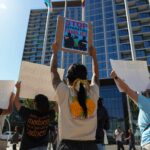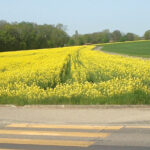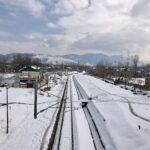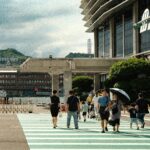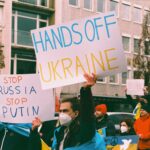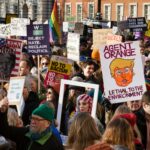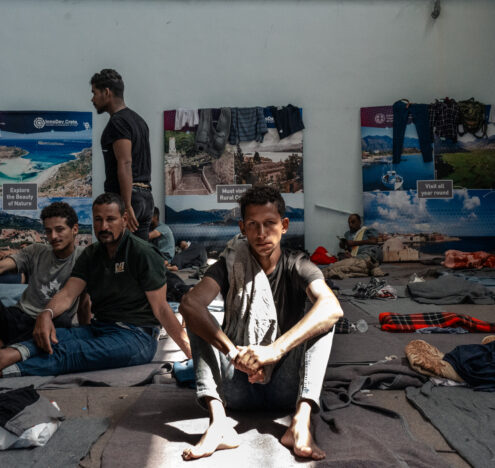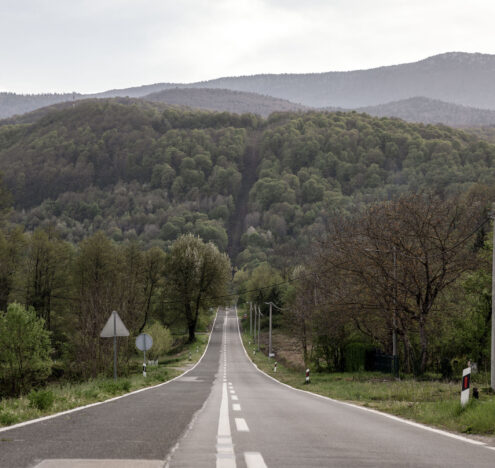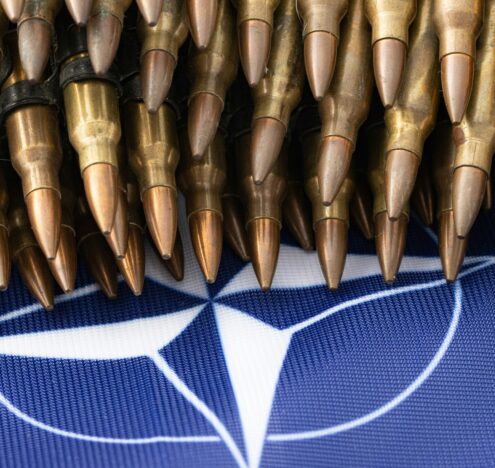In Lebanon’s northern city of Tripoli, the road was loud with a steady stream of cars and motorbikes honking their horns at one another to get out of the way. With a piping hot coffee in hand, Khodr al-Skaf, 65, pointed at a building on the main road. “That’s my home,” the Bab al-Tabbaneh resident said.
Life appeared normal on Syria Street, the de facto border between the Bab al-Tabaaneh and Jabal Mohsen neighborhoods, but previous flare-ups of violence between the communities had left scars. Skaf’s building, like others around it, had been the site of countless incidents during shootouts between Bab al-Tabaaneh residents and their neighbors in Jabal Mohsen.
The last round of fighting took place in 2013 — although several bombings and assassinations hit the area throughout the following two years.
At the entrance of the road that led up to Jabal Mohsen stood a Lebanese Army unit equipped with an armored vehicle and several concrete columns. Army patrols manned stations at all of the neighborhood’s entrances.
After the Syrian civil war erupted in 2011, it reignited tensions between the two neighborhoods. The majority of Jabal Mohsen’s residents are Alawites who supported Bashar al-Assad’s now-toppled regime in Syria, while most of their neighbors downhill in Bab al-Tabaaneh are Sunnis who staunchly opposed the Assad regime.
Now, over a decade since the last time the two neighborhoods clashed, the Assad regime is no longer in power in Syria and, while residents of the two neighborhoods might have differing views on what is happening in the country next door, there is little appetite from either side to see a return to violence.
“Not Forgotten”
For most in Tripoli, there was little to mourn when Assad fled Syria in early December, leaving the country to advancing rebel forces. Rather, people throughout the city fired hundreds of bullets into the air to celebrate.
In fact, the city has a history with the Syrian regime. Syria occupied large parts of Lebanon for decades, and in 1985, the Syrian military entered Tripoli in an attempt to crush the Islamic Unity Movement (Haraket al-Tawheed al-Islami), killing dozens of people. In the years that followed until Syria’s eventual withdrawal from Lebanon in 2005, the regime also disappeared numerous people — many were never heard from again.
While residents of the two neighborhoods might have differing views on what is happening in the country next door, there is little appetite from either side to see a return to violence.
“This of course has not been forgotten in Tripoli,” explained Michael Young, a senior editor at the Carnegie Middle East Center in Beirut.
According to Young, given that Sunni Muslims are a majority of Tripoli’s population, the city has long had a deeper connection to the Sunni community in Syria — in particular the cities of Aleppo, Hama, and Homs.
Outlier
One of the few parts of Tripoli that has remained an outlier is Jabal Mohsen which, because most of its residents belong to the same Alawite sect as the Assad family, has been more supportive of the regime.
This was particularly the case when the Assad regime-backed Arab Democratic Party (ADP) was present in the neighborhood.
Rifaat Eid, who heads the ADP, is a particularly potent figure. He led Jabal Mohsen through the clashes with Bab al-Tabbaneh between 2008 and 2014. Eid fled the country in 2014 after a military judge issued an indictment that could have resulted in the death penalty for him and several other Jabal Mohsen fighters.
Since he left Lebanon, there has been no fighting between the neighborhoods.
“As long as the Eid family is away, and not in the area, there is peace,” said 50-year-old Mahmoud al-Khodr. “If they come back, there will be problems.”
In Bab al-Tabbaneh, residents say they do not have problems with Alawites in general or even the residents of Jabal Mohsen. Rather, it was people like Eid, they argued, who caused tensions and fighting to flare up.
“The Eid family was kind of a gang where they had several bad people who controlled the area in Jabal,” Skaf explained. “As Muslim Sunnis, we don’t have any problem with any Alawites. Just with these specific people.”
“Still in Charge”
Eid may not be in Jabal Mohsen, but he and his party continue to command influence in the area, and locals are quick to argue that Eid and his supporters have not done anything to fan the flames over the past decade.
Hassan, a 24-year-old from Jabal Mohsen, admitted that Eid and his party “are still in charge in our area,” but he added, “They’re from here, and they [have] never bothered anyone since they’re away and minding their own business.”
With the Assad family out of power in Syria, the ADP is no longer as present as it once was in Jabal Mohsen. Young said this fact put the neighborhood’s Alawites in a precarious situation: they no longer have political cover, and Sunnis are enjoying a resurgence following the rebel victory in Syria.
“Without the Assads, the Alawites have suddenly become very, very vulnerable against a revitalized Sunni community,” Young explained. “The political protection that Jabal Mohsen may have enjoyed, I don’t think it is there anymore.”
Chaining smoking in Jabal Mohsen’s main square, Hassan and several of his friends admitted that they felt vulnerable: like many others in the neighborhood, they back Assad but, with his regime’s collapse, they say that their “backbone was been broken.”
“He was our support, and now he’s gone,” Hassan said.
Protector
To Hassan and his friends, Assad defended the Syrian people against rebel groups, such as Hayat Tahrir al-Sham (HTS), who are seeking to implement strict Islamic law and subjugate religious minorities including Alawites, Christians, and Druze.
One of Hassan’s friends chimed in, insisting that Assad “protected” the country. “He backed out at the right time and fled the country just so his people wouldn’t be killed and slaughtered. He did not harm Syrians, but ISIS did. The new leadership belongs to ISIS.”
HTS leader Ahmed al-Sharaa, now Syria’s de facto ruler, was previously part of the Syrian branch of al-Qaeda and briefly made an alliance with ISIS. Al-Sharaa later severed ties with both groups, and in recent years, he has sought to moderate HTS’s stances, repeatedly insisting that Syrians of all religions and sects will enjoy equal treatment under the new government.
Nonetheless, reports have emerged of violence against religious minorities, which the new Syrian government has brushed off as one-off incidents. Government forces have also sought to crack down on what they claim are former regime officials in Alawite-majority parts of the country.
Another of Hassan’s friends explained that, for Alawites who supported the regime, the Assad family’s departure from Syria was similar to the the Lebanese Shia community’s loss of Hassan Nasrallah. On Sept. 27, Israel assassinated Nasrallah in a massive air bombardment on Beirut. Assad, he said, “was like the Sayyed [Nasrallah] to us.”
Despite these political differences, Hassan and many others in Jabal Mohsen say they do not view Bab al-Tabbaneh residents in a negative light. Rather, they say their neighbors are Muslims just like them and, thus, deserve a peaceful life like anyone else.
“Live Together as One”
Ali al-Hussein, 45, is from Jabal Mohsen but owns a small shop in Bab al-Tabbaneh with many of his friends hailing from the neighborhood.
For Hussein, it is just a matter of differing political views between the two neighborhoods but, in the end, they “should live together as one.”
“You can’t say I’m from Jabal so I don’t come here and vice versa,” he said. “The son of Dahiyeh can live in Tripoli and vice versa. We all belong to the same country with the same ID.”
He went on, “We need to live in peace together and leave the politics to the people who are responsible [for them]. We need to forget religion and sects and look at each other as humans.”
Echoing Hussein, Skaf pointed out that Lebanon was built on its diversity, consisting of 18 recognized religious sects, and that it should not matter what someone believes.
“Respect one another rather than fighting,” he stated simply.
“Planted Hatred”
For his part, Khodr went a step further, arguing that the end of the Assad regime presents an opportunity for the two neighborhoods in Tripoli. Because the Assads were part of the reason for the divide between Jabal Mohsen and Bab al-Tabbaneh, he said, the neighborhoods could now forge new ties.
The Assad regime, Khodr said, “started creating problems and planted hatred on both ends. Before them, [we] all lived together as one.”
Neither side may be looking for a fresh conflict, but that does not mean it will be easy to move on from the last few decades. The fighting killed and injured countless people from both communities, Skaf said, and healing those wounds will take a long time.
“Even if there were a lot of solutions and agreements between the political heads,” he said, “people who have lost their brothers and sisters as well as friends and family will never forget.”


